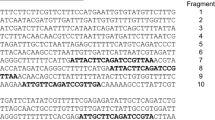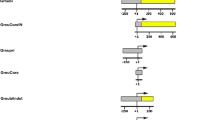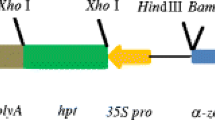Abstract
The genomic clones containing elements that regulate transcription of the three known rice (Oryza sativa L.) alpha-tubulin isotypes (Ostua1, Ostua2 and Ostua3) have been isolated. We have used these genomic regions to identify the regulatory elements that contribute to the expression of a marker gene (gusA) in transient assays performed on rice calli derived from mature embryos. In all cases, we found that the first intron was required to achieve high levels of expression. This is consistent with data already reported for the α-tubulin isotype1 and indicates that a common regulatory mechanism is active on all the members of the rice α-tubulin gene family. The enhancing effect of the first intron was then tested by constructing illegitimate combinations of α-tubulin promoter and intron sequences (Ostua1pro–Ostua2intro; Ostua1pro–Ostua3intro; Ostua2pro–Ostua3intro; Ostua3pro–Ostua2intro) and then by assaying β-glucuronidase (GUS) activity in transformed rice calli. All illegitimate combinations expressed GUS at high level, suggesting that rice α-tubulin promoters and introns can be exchanged among the different isotypes. This did not occur when the intron of the rice β-tubulin isotype16, known to enhance transcription of its own gene, was used in place of the α-tubulin intron. We have also analysed the effect of abscisic acid (ABA) on GUS expression in rice calli transformed with chimeric tubα2pro-intro::gusA and tubα3pro-intro::gusA constructs. ABA was able to reduce GUS expression only in the presence of the tubα2pro-intro sequence. We discuss these data in terms of mechanisms that in rice, as opposed to other plants, may control tubulin isotype-specific expression and the involvement of ABA in the regulation of α-tubulin expression.






Similar content being viewed by others
Abbreviations
- ABA :
-
cis-Abscisic acid
- GFP :
-
Green fluorescent protein
- GUS :
-
Escherichia coli β-glucuronidase
- MT :
-
Microtubule
- UTR :
-
Untranslated region
References
Anthony RG, Hussey PJ (1999) Double mutation in Eleusine indica alpha-tubulin increases the resistance of transgenic maize calli to dinitroaniline and phosphorothioamidate herbicides. Plant J 18:669–674
Baker SS, Wilhem KS, Tomashow MF (1994) The 5′-region of Arabidopsis thaliana cor15a has cis-acting elements that confer cold-, drought- and ABA-regulated gene expression. Plant Mol Biol 24:701–713
Bao Y, Kost B, Chua N H (2001) Reduced expression of alpha-tubulin genes in Arabidopsis thaliana specifically affects root growth and morphology, root hair development and root gravitropism. Plant J 28:145–57
Boyko V, Ferralli J, Ashby J, Schellenbaum P, Heinlein M (2000) Function of microtubules in intercellular transport of plant virus RNA. Nat Cell Biol 2:826–32
Breviario D, Nick P (2000) Plant tubulins: a melting pot for basic questions and promising applications Transgenic Res 9:383–393
Breviario D, Gianì S, Meoni C (1995) Three rice cDNAs clones encoding different beta-tubulin isotypes. Plant Physiol 108:823–824
Canaday J (2000) Higher plant cells: gamma-tubulin and microtubule nucleation in the absence of centrosomes. Microsc Res Tech 49:487–95
Carpenter JL, Ploense C, Snustad DP, Silflow CD (1992) Preferential expression of an α-tubulin gene of Arabidopsis in pollen. Plant Cell 4:557–571
Cheng Z, Snustad DP, Carter JV (2001) Temporal and spatial expression patterns of TUB9, a beta-tubulin gene of Arabidopsis thaliana. Plant Mol Biol 47:389–98
Chu B, Wilson TJ, McCune-Zierath C, Snustad DP, Carter JV (1998) Two beta-tubulin genes, TUB1 and TUB8, of Arabidopsis exhibit largely nonoverlapping patterns of expression. Plant Mol Biol 37:785–790
Cleveland DW (1988) Autoregulated instability of tubulin mRNAs: a novel eukaryotic regulatory mechanism. Trends Biol Sci 13:339–343
Doyle MC, Han IS (2001) The roles of two TATA boxes and 3′-flanking region of soybean beta-tubulin gene (tubB1) in light-sensitive expression. Mol Cells 12:197–203
Ebel C, Gomez LG, Schmit AC, Neuhaus-Url G, Boller T (2001) Differential mRNA degradation of two beta-tubulin isoforms correlates with cytosolic Ca(2+) changes in glucan-elicited soybean cells. Plant Physiol 126:87–96
Erhardt M, Stoppin-Mellet V, Campagne S, Canaday J, Mutterer J, Fabian T, Sauter M, Muller T, Peter C, Lambert A-M, Schmit AC (2002) The plant Spc98p homologue colocalizes with γ-tubulin at microtubule nucleation sites and is required for microtubule nucleation. J Cell Sci 115:2423–2431
Ezcurra I, Ellestrom M, Wycliffe P, Stalberg K, Rask L (1999) Interaction between composite elements in the napA promoter: both the B-box ABA-responsive complex and the RY/G complex are necessary for seed-specific expression. Plant Mol Biol 40:699–709
Gay DA, Sisodia SS, Cleveland DW (1989) Autoregulatory control of β-tubulin mRNA stability is linked to translational elongation. Proc Natl Acad Sci USA 86:5763–5767
Gianì S, Qin X, Faoro F, Breviario D (1998) In rice, Oryzalin and abscisic acid differentially affect tubulin mRNA and protein levels. Planta 205:334–341
Gillespie T, Boevink P, Haupt S, Roberts AG, Toth R, Valentine T, Chapman S, Oparka JK (2002) Functional analysis of a DNA-shuffled movement protein reveals that microtubules are dispensable for the cell-to-cell movement of tobacco mosaic virus. Plant Cell 14:1207–22
Jefferson RA (1987) Assaying chimeric genes in plants: the GUS gene fusion system. Plant Mol Biol Rep 5:387–405
Jeon JS, Lee S, Jung KH, Jun SJ, Kim C, An G (2000) Tissue-preferential expression of a rice α-tubulin gene, OsTubA1, mediated by the first intron. Plant Physiol 123:1005–1014
Kang MS, Choi YJ, Kim MC, Lim CO, Hwang I, Cho MJ (1994) Isolation and characterization of two β-tubulin cDNA clones from rice. Plant Mol Biol 26:1975–1979
Keating TJ, Borisy GG (2000) Immunostructural evidence for the template mechanism of microtubule nucleation. Nat Cell Biol 2:352–357
Koga-Ban Y, Niki T, Nagamura Y, Sasaki T, Minobe Y (1995) cDNA sequences of three kinds of β-tubulins from rice. DNA Res 2:21–26
Kopczak SD, Haas NA, Hussey PJ, Silflow CD, Snustad DP (1992) The small genome of Arabidopsis contains at least six expressed α-tubulin genes. Plant Cell 4:539–547
Luduena RF (1998) Multiple forms of tubulin: different gene products and covalent modifications. Int Rev Cytol 178:207–275
Mendu N, Silflow CD (1993) Elevated levels of tubulin transcripts accompany the GA3-induced elongation of oat internode segments. Plant Cell Physiol 34:973–983
Montoliu L, Rigau J, Puigdomènech P (1989) A tandem of α-tubulin genes preferentially expressed in radicular tissues from Zea mays. Plant Mol Biol 14:1–15
Morello L, Bardini M, Sala F, Breviario D (2002) A long leader intron of the Ostub16 rice beta-tubulin gene is required for high-level gene expression and can autonomously promote transcription both in vivo and in vitro. Plant J 29:33–44
McNally FJ (1996) Modulation of microtubule dynamics during the cell cycle. Curr Opin Cell Biol 8:23–29
Nick P (1998) Signaling to the microtubular cytoskeleton in plants. Int Rev Cytol 184:33–80
Olinevich OV, Khokhlova LP, Raudaskoski M (2002) Effect of abscisic acid and cold acclimation on the cytoskeletal and phosphorylated proteins in different cultivars of Triticum aestivum L. Cell Biol Int 24:365–373
Qin X, Gianì S, Breviario D (1997) Molecular cloning of three rice α-tubulin isotypes: differential expression in tissues and during flower development. Biochim Biophys Acta 1354:19–23
Rose AB (2002) Requirements for intron-mediated enhancement of gene expression in Arabidopsis. RNA 8:1444–1453
Simpson CG, Thow G, Clark GP, Jennings SN, Watters JA, Brown JW (2002) Mutational analysis of a plant branchpoint and polypyrimidine tract required for constitutive splicing of a mini-exon. RNA 8: 47–56
Sinibaldi RM, Mettler IJ (1989) Intron splicing and intron-mediated enhanced expression in monocots. Prog Nucleic Acid Res Mol Biol 42:229–255
Smertenko A, Blume Y, Viklicky V, Opatrny Z, Draber P (1997) Post-translational modifications and multiple tubulin isoforms in Nicotiana tabacum L. cells. Planta 201:349–358
Snustad DP, Haas NA, Kopczack SD, Silflow CD (1992) The small genome of Arabidopsis contains at least nine expressed β-tubulin genes. Plant Cell 4:549–556
Stotz HU, Long SR (1999) Expression of the pea (Pisum sativum L.) alpha-tubulin gene TubA1 is correlated with cell division activity. Plant Mol Biol 41:601–614
Thitamadee S, Tuchihara K, Hashimoto T (2002) Microtubule basis for left-handed helical growth in Arabidopsis. Nature 417:193–196
Tonoike H, Han IS, Jongewaard I, Doyle M, Guiltinan M, Fosket DE (1994) Hypocotyl expression and light downregulation of the soybean tubulin gene, tubB1. Plant J 5:343–35
Uribe X, Torres MA, Capellades M, Puigdomènech P, Rigau J (1998) Maize α-tubulin genes are expressed according to specific patterns of cell differentiation. Plant Mol Biol 37:1069–1078
Vain P, Mc Mullen M, Finer J (1993) Osmoticum treatment enhances particle bombardment-mediated transient and stable transformation of maize. Plant Cell Rep 12:84–88
Villemur R, Joyce CM, Haas NA, Goddard RH, Kopczak SD, Hussey PJ, Snustad DP, Silflow CD (1992) α-tubulin gene family of maize (Zea mays L.): evidence for two ancient α- tubulin genes in plants. J Mol Biol 227:81–96
Villemur R, Haas NA, Joyce CM, Snustad DP, Silflow CD (1994) Characterization of four new β-tubulin genes and their expression during male flower development in maize (Zea mays L.). Plant Mol Biol 24:295–315
Wasteneys GO (2002) Microtubule organization in the green kingdom: chaos or self-order? J Cell Sci 115:1345–1354
Wiesler B, Wang QY, Nick P (2002) The stability of cortical microtubules depends on their orientation. Plant J 32:1023–1032
Wu C, Washida H, Onodera Y, Harada K, Takaiwa F (2000) Quantitative nature of the Prolamin-box, ACGT and AACA motifs in a rice glutelin gene promoter: minimal cis-element requirements for endosperm-specific gene expression. Plant J 23:415–421
Acknowledgements
This work was partially supported by contract N. QLK3-2000-00060 from the European Commission. We also acknowledge the support we had from the Italian Ministery of Education and Research (MIUR) within the FIRB programme frameshift (project N. RBNE01TYZF).
Author information
Authors and Affiliations
Corresponding author
Additional information
EBI GenBank Accession numbers for Ostua1, Ostua2 and Ostua3 promoter, first exon and first intron sequences are AJ488065, AJ488063 and AJ488064, respectively.
Rights and permissions
About this article
Cite this article
Fiume, E., Christou, P., Gianì, S. et al. Introns are key regulatory elements of rice tubulin expression. Planta 218, 693–703 (2004). https://doi.org/10.1007/s00425-003-1150-0
Received:
Accepted:
Published:
Issue Date:
DOI: https://doi.org/10.1007/s00425-003-1150-0




